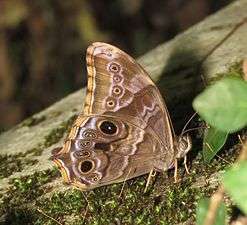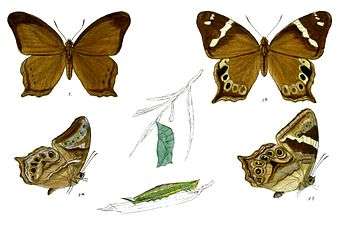Lethe drypetis
Lethe drypetis, the Tamil treebrown,[1][2] is a species of Satyrinae butterfly found in south India and Sri Lanka.[1][2]
| Tamil treebrown | |
|---|---|
 | |
| Female in Peravoor, Kerala, India | |
| Scientific classification | |
| Kingdom: | |
| Phylum: | |
| Class: | |
| Order: | |
| Family: | |
| Genus: | Lethe |
| Species: | L. drypetis |
| Binomial name | |
| Lethe drypetis (Hewitson, 1863) | |
Description

Male upperside very dark Vandyke brown; forewing uniform: hindwing with a postdiscal series of three or four blind black ocellar spots. Underside, brown; forewing below vein 2 and terminal margin paler, a broad band across the cell, the wing medially and at apex suffused with lilac, bearing an incurved postdiscal series of five, blind black ocelli. Hindwing: subbasal and discal narrow transverse lilac bands, the former sinuous, the latter angulated on vein 4, and an arched postdiscal series of black fulvous-ringed ocelli, some with disintegrate centres; the wing medially suffused with lilac, the ocelli with lilacine lunules on both sides. Forewings and hindwings with slender lilacine subterminal and broader ochraceous terminal lines.[3]
Female similar, ground colour paler; a broad oblique white discal bar and two white preapical spots on the upperside of the forewing; a large, rectangular, black subterminal mark in interspaces and a white spot above and below it, on the upperside of the hindwing. Underside similar to the underside in the male, all the markings more prominent, the lilac, ochraceous and brown shades paler; the broad discal bar on forewing, as on the upperside, joined by a nearly vertical lilacine white band bearing the series of ocelli.[3][4]
On the hindwing the brown transverse discal band very broadly produced between veins 4 and 5. Antennae, head, thorax and abdomen brown; antennae ochraceous at apex.[3]
Wingspan 64–68 mm.[3]
Found in southern India and Sri Lanka.[3]
Life history
Larva. "Fusiform; head conical, the vertex pointed and projected forward, anal segment pointed and projected hind ward. Colour pale green, with paler transverse lines on each segment; a lateral and a sublateral pale-bordered reddish stripe extending the whole length including the anal segment. Feeds on bamboo." (After Frederic Moore)[3]
Pupa. "Suspended by the tail, broad and truncated anteriorly, abdominal segments dorsally convex, head and vertex both pointed; colour pale green." (After Moore)[3]
References
- Varshney, R.K.; Smetacek, Peter (2015). A Synoptic Catalogue of the Butterflies of India. New Delhi: Butterfly Research Centre, Bhimtal & Indinov Publishing, New Delhi. p. 165. doi:10.13140/RG.2.1.3966.2164. ISBN 978-81-929826-4-9.
- Savela, Markku. "Lethe drypetis (Hewitson, 1863)". Lepidoptera and Some Other Life Forms. Retrieved July 2, 2018.
-

-
